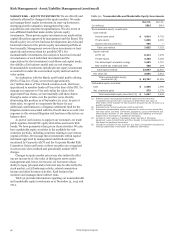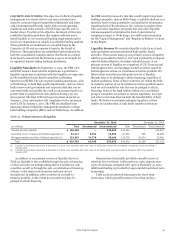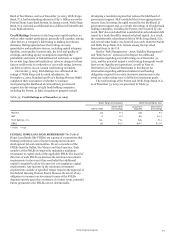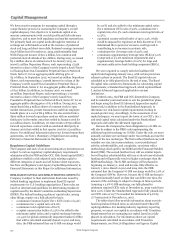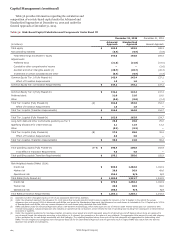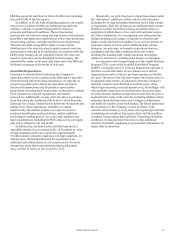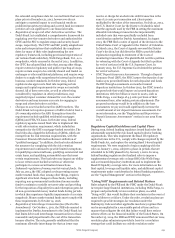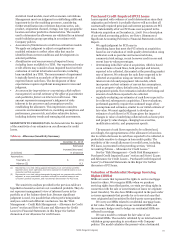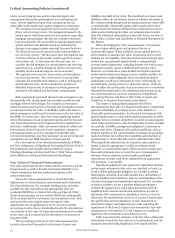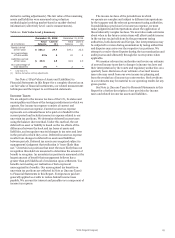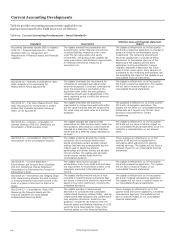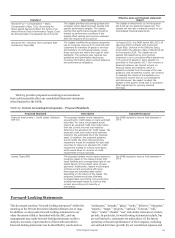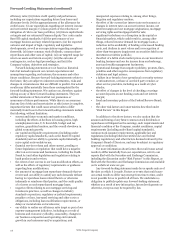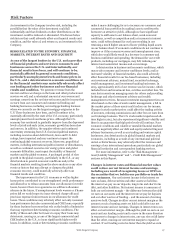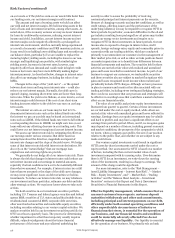Wells Fargo 2015 Annual Report Download - page 110
Download and view the complete annual report
Please find page 110 of the 2015 Wells Fargo annual report below. You can navigate through the pages in the report by either clicking on the pages listed below, or by using the keyword search tool below to find specific information within the annual report.
Regulatory Reform
Since the enactment of the Dodd-Frank Act in 2010, the U.S. • Regulation of consumer financial products. The Dodd-
financial services industry has been subject to a significant Frank Act established the Consumer Financial Protection
increase in regulation and regulatory oversight initiatives. This Bureau (CFPB) to ensure consumers receive clear and
increased regulation and oversight has substantially changed accurate disclosures regarding financial products and to
how most U.S. financial services companies conduct business protect them from hidden fees and unfair or abusive
and has increased their regulatory compliance costs. The practices. With respect to residential mortgage lending, the
following highlights the more significant regulations and CFPB issued a number of final rules in 2013 implementing
regulatory oversight initiatives that have affected or may affect new origination, notification and other requirements that
our business. For additional information about the regulatory generally became effective in January 2014. In November
reform matters discussed below and other regulations and 2013, the CFPB also finalized rules integrating disclosures
regulatory oversight matters, see Part I, Item 1 “Regulation and required of lenders and settlement agents under the Truth
Supervision” of our 2015 Form 10-K, and the “Capital in Lending Act (TILA) and the Real Estate Settlement
Management,” “Forward-Looking Statements” and “Risk Procedures Act (RESPA). These rules, which became
Factors” sections and Note 26 (Regulatory and Agency Capital effective in October 2015, combine existing separate
Requirements) to Financial Statements in this Report. disclosure forms under the TILA and RESPA into new
integrated forms and provide additional limitations on the
Dodd-Frank Act fees and charges that may be increased from the estimates
The Dodd-Frank Act is the most significant financial reform provided by lenders. In October 2015, the CFPB finalized
legislation since the 1930s and is driving much of the current amendments to the rule implementing the Home Mortgage
U.S. regulatory reform efforts. The Dodd-Frank Act and many of Disclosure Act, resulting in a significant expansion of the
its provisions became effective in July 2010 and July 2011. data points lenders will be required to collect beginning
However, a number of its provisions still require final January 1, 2018 and report to the CFPB beginning January
rulemaking or additional guidance and interpretation by 1, 2019. The CFPB also expanded the transactions covered
regulatory authorities or will be implemented over time. by the rule and increased the reporting frequency from
Accordingly, in many respects the ultimate impact of the Dodd- annual to quarterly for large volume lenders, such as
Frank Act and its effects on the U.S. financial system and the Wells Fargo, beginning January 1, 2020. With respect to
Company remain uncertain. The following provides additional other financial products, in November 2014, the CFPB
information on the Dodd-Frank Act, including the current status issued a proposed rule to expand consumer protections for
of certain of its rulemaking initiatives. prepaid products such as prepaid cards. The proposal would
• Enhanced supervision and regulation of systemically make prepaid cards subject to similar consumer protections
important firms. The Dodd-Frank Act grants broad as those provided by more traditional debit and credit cards
authority to federal banking regulators to establish such as fraud protection and expanded access to account
enhanced supervisory and regulatory requirements for information.
systemically important firms. The FRB has finalized a In addition to these rulemaking activities, the CFPB is
number of regulations implementing enhanced prudential continuing its on-going supervisory examination activities
requirements for large bank holding companies (BHCs) like of the financial services industry with respect to a number of
Wells Fargo regarding risk-based capital and leverage, risk consumer businesses and products, including mortgage
and liquidity management, and imposing debt-to-equity lending and servicing, fair lending requirements, student
limits on any BHC that regulators determine poses a grave lending activities, and auto finance. At this time, the
threat to the financial stability of the United States. The FRB Company cannot predict the full impact of the CFPB’s
and OCC have also finalized rules implementing stress rulemaking and supervisory authority on our business
testing requirements for large BHCs and national banks. practices or financial results.
The FRB has also proposed, but not yet finalized, additional • Volcker Rule. The Volcker Rule, with limited exceptions,
enhanced prudential standards that would implement single prohibits banking entities from engaging in proprietary
counterparty credit limits and establish remediation trading or owning any interest in or sponsoring or having
requirements for large BHCs experiencing financial distress. certain relationships with a hedge fund, a private equity
In addition to the authorization of enhanced supervisory fund or certain structured transactions that are deemed
and regulatory requirements for systemically important covered funds. On December 10, 2013, federal banking
firms, the Dodd-Frank Act also established the Financial regulators, the SEC and CFTC (collectively, the Volcker
Stability Oversight Council and the Office of Financial supervisory regulators) jointly released a final rule to
Research, which may recommend new systemic risk implement the Volcker Rule’s restrictions. Banking entities
management requirements and require new reporting of were required to comply with many of the Volcker Rule’s
systemic risks. The OCC, under separate authority, has also restrictions by July 21, 2015. However, the FRB has
finalized guidelines establishing heightened governance and extended the rule’s compliance date to give banking entities
risk management standards for large national banks such as until July 21, 2016, to conform their ownership interests in
Wells Fargo Bank, N.A. The OCC guidelines require covered and sponsorships of covered funds that were in place prior
banks to establish and adhere to a written risk governance to December 31, 2013, and the FRB has announced that it
framework in order to manage and control their risk-taking intends to provide an additional one-year extension to this
activities. The guidelines also formalize roles and date in the future. As a banking entity with more than
responsibilities for risk management practices within $50 billion in consolidated assets, we are also subject to
covered banks and create certain risk oversight enhanced compliance program requirements. We expect to
responsibilities for their boards of directors. have to make divestments in non-conforming funds prior to
Wells Fargo & Company
108


